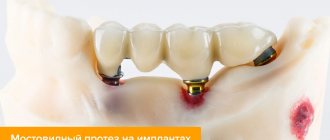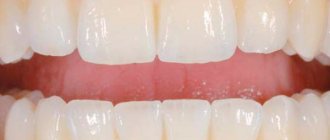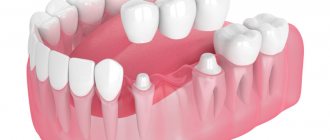Installing crowns is one of the most effective ways to restore teeth. How can you determine that the prosthesis is of adequate quality and that the fixation procedure was carried out according to all the rules? It’s very simple: artificial teeth should not be visually different from real teeth. By and large, such a result can only be achieved if two conditions are met: the doctor installing ceramic crowns must be a true professional, and the structure itself is made of solid ceramics. Andrey Nikolaevich Karneev, leading orthopedist at the German Implantology Center, spoke about what a ceramic crown on a tooth is.
Prices for installing crowns at the CLINIC OF DOCTOR ZHURAVLEV
| Solid crown | PC. | 3600 rub. |
| Metal-ceramic crown | PC. | 6000 rub. |
| Metal-ceramic crown on an implant | PC. | 15,000 rub. |
| Zirconium oxide crown for implant | PC. | 16,000 rub. |
| Crown based on zirconium oxide | PC. | 13000 rub. |
| Endocrown | PC. | 12000 rub. |
| Pressed ceramic crown | PC. | 14,000 rub. |
Rules of care
Patients who have undergone prosthetics are interested in the question of how to care for ceramic structures. To extend the life of expensive crowns made of zirconium and porcelain, you must adhere to basic rules. So, daily care involves avoiding hard foods (which need to be chewed) and regularly thoroughly brushing your teeth (do not use toothpastes with a high degree of abrasiveness).
Ceramic prosthetics eliminates the development of gingivitis and other inflammatory processes affecting the soft tissues of the oral cavity
Important! A preventive examination by a dentist twice a year is an important measure that allows not only to avoid problems with installed dentures, but also to promptly identify caries, gingivitis, periodontitis and other inflammatory diseases of the oral cavity.
Photos before and after treatment with ceramic crowns
The content of the article
- What are the advantages of a ceramic crown?
- What types of ceramic crowns are there?
- Ceramic crowns for front teeth
- How are ceramic crowns placed?
- What is the service life of a ceramic crown?
- Restoration of ceramic crowns
- Which is better – ceramic or metal-ceramic crowns?
- Differences between crowns and ceramic inlays
- How much does a ceramic crown cost?
Installing crowns is one of the most effective ways to restore teeth. How can you determine that the prosthesis is of adequate quality and that the fixation procedure was carried out according to all the rules? It’s very simple: artificial teeth should not be visually different from real teeth. By and large, such a result can only be achieved if two conditions are met: the doctor installing ceramic crowns must be a true professional, and the structure itself is made of solid ceramics. We will tell you what a ceramic crown on a tooth is in this article.
Service life of dental crowns
If you are interested in a tooth crown and what material is best for its manufacture, an important point is the service life of the product. For example, prosthetic devices made of metal-ceramics can be used for 8-10 years, zirconium structures - over 15-20 years, glass-ceramic products - over 15 years.
However, when studying the properties of dental crowns and trying to find out which ones are better suited for prosthetics in a particular area of the jaw, one should not forget about compliance with the patient’s care requirements and the quality of the procedure performed by the dentist.
Under normal conditions, assuming proper training of the doctor and strict compliance with the production concept, the service life of crowns cannot be less than 10 years.
What are the advantages of a ceramic crown?
Today, ceramic dental crowns are the most aesthetically pleasing orthopedic structures installed both in the smile area and on chewing teeth. Ceramics is biologically inert and indifferent, is not perceived by the body as something foreign, does not absorb foreign odors, pigments and bacteria, does not emit harmful substances, and is also very durable. High-quality dentures cannot be distinguished from natural teeth.
3 main advantages of ceramic crowns
- Superior Aesthetics
- Hypoallergenic
- Reliability
Caring for tooth crowns
When studying the topic of dental crowns and trying to understand which ones are better, many rely on reviews from other patients and specialists. At the same time, any qualified doctor will tell you that to extend the life of a prosthetic device, you first need to pay attention to the rules of care.
For example, if you have a single crown installed, it is enough to carry out regular hygiene procedures using toothpaste, brush and dental floss. In the presence of bridge structures, as well as in patients with periodontal pockets in the area of dentures, it is necessary to resort to the help of irrigators. These devices help clean hard-to-reach areas from dental plaque and food debris.
Article expert (author):
What types of ceramic crowns are there?
Pressed ceramic crown
The most advanced type is the pressed ceramic crown. The design is highly durable, more accurately reproduces the color of natural teeth, and to install the prosthesis there is no need for strong grinding of the teeth, as is required for fixing structures made from other materials. The last advantage is extremely important, since the service life of the prosthesis depends on the amount of preserved natural dental tissue.
The most famous types of dentures made of pressed ceramics are created using E-max and Empress technologies.
- The E-max ceramic crown is made of lithium disilicate, that is, glass ceramics, which has a high degree of strength and is ideal for prosthetics in both the anterior and chewing regions.
- The Empress ceramic crown is made from the same material, but with the addition of leucite crystals, a mineral of igneous origin. The structures have excellent aesthetic characteristics, but are not able to withstand heavy loads, so they are installed only in the smile area.
Ceramic zirconium crowns
Often, prostheses made of zirconium are classified as metal-free ceramic crowns, which is fundamentally incorrect. Zirconium dioxide is the same metal, only white. Unlike ceramics, it does not have sufficient transparency, and its color palette is very limited. But, on the other hand, this material has good strength. Which crowns are better – ceramic or zirconium? Zirconium dioxide ceramic crowns are more suitable for restoring chewing teeth. In the frontal section, preference should be given to designs made of metal-free ceramics.
Ceramic crowns on a zirconium dioxide frame
A crown on a zirconium base, coated with a layer of ceramics, is the latest development in prosthetics. The white material, unlike metal, does not shine through the porcelain shell, which allows you to achieve excellent aesthetic results with high strength and wear resistance of the structure. In addition, the biocompatibility of a ceramic crown on a zirconium frame eliminates the risk of allergies and periodontal inflammation.
When does a doctor recommend installing a crown on your teeth?
If the chewing tooth is destroyed, but the dentist does not see the need for removal, then, depending on the degree of destruction, the doctor uses fillings or crowns to restore it.
A problematic back tooth cannot be restored or two or three adjacent units are missing - in the first case, the orthopedist removes the tooth and immediately implants an implant in its place, followed by installing a crown on it.
In the second case, the doctor recommends restoring the chewing teeth using a permanent prosthesis - a bridge with crowns, which is attached to adjacent supporting teeth.
How are ceramic crowns placed?
Installing a ceramic crown involves the following steps.
1. Preparation. The patient undergoes a visual examination, X-ray diagnostics, canal treatment and gentle grinding of the tooth - the specialist removes much less dental tissue than for crowns made of other materials. An additional advantage is that removal of the nerve is not a prerequisite for attaching a ceramic prosthesis.
2. Making a ceramic crown. The doctor takes impressions of the jaws and sends them, along with x-rays, to the laboratory, where a plaster model is made to create an orthopedic structure using one of two technologies:
- hot pressing with layer-by-layer application of ceramics;
- computer modeling CAD/CAM and milling.
| If the tooth tissue is severely damaged and there is no reliable base for the prosthesis, a stump inlay is first placed under a ceramic crown. More recently, under similar circumstances, a ceramic crown was installed on a pin, but today the method is outdated and is practically not used in clinics. |
3. Fixation of the ceramic crown. The procedure is carried out using a special cement or primer, which is polymerized by light. A ceramic crown, like any other, can be placed correctly only by an experienced orthopedist. Poor quality prosthetics leads to inflammatory processes in the gum tissue, tooth destruction and loss of the structure.
Dental crowns: criteria for choosing the best option for prosthetics
When choosing the best crown to restore a tooth, the following criteria will definitely be taken into account:
- The degree of tooth decay;
- The area of the dental unit that needs to be restored;
- The patient's wishes regarding the aesthetics of the result.
The location of the tooth that needs to be restored with a crown is a very important criterion when selecting it, because our teeth - the front and chewing ones - are subject to different loads. The chewing teeth are regularly subjected to a heavy load every time we eat something, and therefore the crown installed on the back chewing tooth must be strong and resistant to mechanical stress.
IMPORTANT: If your chewing tooth is severely damaged - more than 50%, it needs to be restored with a crown. Large fillings do not hold well, they can fall out or, even worse, break off along with part of the tooth. If the tooth splits in half or the root is damaged, the tooth will have to be removed and then implanted. Therefore, for damaged teeth, the best restoration option is to install a crown, not a filling!
But strength alone is not enough: a crown for a chewing tooth should help restore all the functions of a lost/damaged tooth, ensure proper distribution of the chewing load and have the longest possible useful life.
Taking into account all these requirements, the material for making a crown for a chewing tooth is selected. For prosthetics of back teeth, the following types of crowns are most often used: metal, metal-ceramics, zirconium. Which crown will be the best? To understand this issue, you need to study the characteristics, pros and cons of different types of crowns.
What is the service life of a ceramic crown?
Metal-ceramic crowns are fixed with dental cement, which breaks down after about 5 to 7 years. However, ceramic dentures are attached to a particularly strong adhesive material, which increases their service life to 10 years.
As for strength, ceramic crowns can easily withstand the required chewing load. If a ceramic crown chips for some reason, it can be easily restored. Since the metal-free structure does not have a frame, almost any minor damage to it will be invisible. If more or less serious damage occurs, the all-ceramic crown can simply be polished.
Features of prosthetics
Preparation for installing a crown involves a visual examination of the damaged tooth by an orthodontist, x-rays, treatment, and a filling must be placed under the prosthesis. After the described manipulations, the corresponding tooth is ground (the required layer of bone tissue is removed - its thickness is usually 1.5–2 mm, depending on the size of the crown walls).
Important! If the tooth apex is completely missing, a metal inlay is placed under the ceramic prosthesis.
Otherwise, the procedure for prosthetics using ceramic material is no different from working with other crowns. Dentists perform manipulations in the following sequence:
Crown inlay
- First, a cast is made;
- make a model of the future product from plaster;
- select the required shade of ceramics (in accordance with a special scale);
- Then the crown itself is made in the laboratory.
The last stage of prosthetics is fitting (adjusting) the structure, fixing it first with temporary cement, and then with a previously prepared tooth. Upon completion of the manipulations, the patient may experience unpleasant painful sensations.
Lightness, strength, hypoallergenicity, aesthetically attractive appearance - these are the properties due to which ceramic prostheses are gradually displacing their metal and metal-ceramic counterparts from the dental market
Discomfort occurs for various reasons:
- if the size and shape of the crown were initially chosen incorrectly;
- when the edges of the product do not fit tightly to the gum.
Restoration of ceramic crowns
Despite the strength of modern ceramic dentures, the query “The ceramic has broken off from the crown, what should I do?” found on the Internet quite often. Typically a defect occurs for the following reasons:
- injury - blow or fall;
- defects in the work of a dental technician;
- malocclusion, bruxism;
- strong mechanical impact on the structure during chewing.
There are two possible solutions to the problem - replacement and restoration.
- Replacement of prosthesis. The crown is removed from the mouth, and the entire prosthetic process is repeated from the moment the impressions are taken until the new structure is attached.
- Restoration. The chip on the ceramic crown is polished to the optimal shape, and a light-curing composite material is placed into the cavity. After hardening, the specialist models the coating, forms bumps and fissures, and grinds uneven edges to the desired size.
The advantages of repair are short time and low cost; chipped ceramics on the crown can be restored in an hour in the dentist’s chair. However, even the use of the most modern materials does not provide the quality that is obtained when making a prosthesis “from scratch” in a dental laboratory. If the cause of the chip was carelessness when chewing hard food, after repair the denture will last for many years. Malocclusions and other pathologies of the dental system reduce the service life of the restored crown several times.
Types of Best Dental Crowns for 2021
Modern dentistry offers patients crowns made from various materials. It is this indicator that is key in determining the cost, quality parameters and indications for the use of a particular prosthesis. Another important criterion on which the quality of a product depends is the production method.
The following crowns are currently in demand:
- Metal-ceramic. They are among the most popular prosthetic devices. Includes a metal base and an outer facing layer of ceramics. Initially, the frame is made, after which the ceramic coating is performed. The production process can be carried out on the basis of modern computer programs and aesthetic modeling.
- All-ceramic. In the manufacture of such prostheses, metal-free ceramics are used. Provides maximum safety in relation to soft tissues, which is due to the biological inertness of this material. The manufacturing process is based on the firing technique; ceramic pressing technologies; use of milling equipment and modern digital programs.
- Crowns made of zirconium material. Despite its origin (metal), zirconium dioxide is famous for its unrivaled aesthetics and increased safety. The manufacturing process is based on the use of specialized digital programs and milling equipment. Two versions of such prostheses can be used: combined (include a base of zirconium material and ceramic lining) and monolithic (made of zirconium oxide without the use of a ceramic coating).
- Glass ceramics e.max. It is distinguished by perfect aesthetic parameters and the necessary strength. There are currently 2 material options in use: E.max RPESS - produced by injection molding using elevated pressure and temperature conditions, and E-max CAD - produced using modern digital applications and milling machines (CAD/CAM concept).
Which is better – ceramic or metal-ceramic crowns?
- Unlike metal-ceramics, metal-free crowns do not have a metal frame, thanks to which they perfectly imitate the structure, color and transparency of natural dental tissues. Therefore, with their help, you can not only solve such functional problems as restoring a damaged tooth, but also do it as beautifully and naturally as possible.
- In addition, ceramic crowns are thinner than metal-ceramic crowns, therefore they require minimal grinding of the tooth, and are held very firmly and tightly to it due to a special fixing cement, thereby preventing the penetration of bacteria under the crown.
- The gums around them never become inflamed, since the crowns are very precisely fitted to the teeth, and they do not have a metal frame that can oxidize.
Properties of ceramics
The main advantage that metal-free crowns have is biological inertness. This means that the human body does not react to prostheses as if they were a foreign object and does not reject them. Ceramic teeth have other advantages:
- they contain no harmful impurities;
- the material does not absorb any odors;
- crowns made of metal-free ceramics do not stain and do not react with bacteria and pigments;
- designs do not cause gum inflammation;
- strength;
- visually similar to natural teeth;
- an all-ceramic crown allows you to accurately reproduce the natural shade, transparency and even the structure of bone tissue;
- ceramic fixed dentures do not have a metal frame - accordingly, they are much thinner and lighter than their “brothers”.
Differences between crowns and ceramic inlays
The doctor decides what to restore a tooth with - a ceramic inlay or a crown - after assessing its condition. If more than 60% is destroyed, a crown is used, if from 40 to 50%, a ceramic inlay is used. The design does not require removal of the nerve and allows the preservation of a living dental unit. To some extent, the inlay is an analogue of a light-curing filling, but differs from it in that it is made in a dental laboratory using individual impressions, is characterized by high strength and fits as tightly as possible to the dental tissues.
Reviews from doctors and patients
Dentists consider dentures with crowns to be an excellent way to restore significantly damaged elements. Doctors note a significant advantage of this solution - it is an opportunity to prevent the destruction of a “dead” tooth or even preserve a “living” unit (if it is partially destroyed). This method cannot be called universal only because it has a number of contraindications, one of which is root damage.
Patients, for the most part, speak positively about prostheses of this type. They note the rapid restoration of functionality and aesthetics of the series, ease of use and durability of the prostheses.
Free consultation
Our specialists will conduct a free consultation and select the best treatment option for you.
Sign up now! Online registration
+7 (495) 649-41-19
e.max crowns on front teeth
When considering crowns for the front teeth, we strive to give a clear answer as to which ones are better aesthetically and functionally. The undisputed leader in this direction is Emax glass ceramics. This is an improved modern material, the creation of which is based on the use of lithium disilicate, which has impeccable characteristics. Emax ceramic crowns look perfect on the front teeth because they have light transmission that fully matches natural enamel. The same can be said about veneers made from the above material; they are completely indistinguishable from natural teeth
Today there are 2 known options for Emax materials:
- E.maxPRESS. Widely used to obtain dentures and veneers. This involves the injection molding method under the influence of pressure and high temperature conditions. Such crowns are indispensable when restoring single teeth or creating short bridge structures.
- E.maxCAD. In the production of this material, modern computer technologies and computer-controlled machines are used. Such crowns are characterized by less high reliability, which eliminates the possibility of creating bridge structures and ultra-thin veneers. Also among the disadvantages of E.maxCAD is the limited selection of shades, which reduces the chances of obtaining a design identical in color to natural enamel.
What are the best crowns for front teeth?
Today, dental clinics use several options for orthopedic structures for front teeth: metal-ceramic prostheses, zirconium crowns, solid ceramic products and improved E-MAX models.
Many visitors to modern dentistry are interested in: “Which crowns are best to fix on the upper front teeth?” In this case, the preferred option would be to install all-ceramic structures. For the manufacture of prostheses of the above type, porcelain material is used, obtained by injection molding or by layer-by-layer application. Alternative designs also include ceramic prostheses on a zirconium base.
Cost of crowns for front teeth
Below we will give approximate prices for crowns on the front teeth - this price is set in mid-level dentists.
For example, if you are interested in metal-ceramic crowns for your front teeth, the price for them in metropolitan clinics has a lower limit of 7 thousand rubles per product and higher. This price includes services for the production of the prosthesis and its fixation. All other therapeutic procedures are considered additional costs.
The cost of ceramic crowns for the front teeth is close to 15-16 thousand rubles and more. In turn, you will have to pay at least 20 thousand rubles for zirconium structures. A crown for 2 front teeth or crowns for 4 front teeth will require more significant financial investments from you. But if a specialist of the highest category works with you, the result will pay for all the money spent.
At the same time, temporary crowns made of plastic on the front teeth, which are installed on the patient before fixing permanent orthopedic structures, are considered the most budget-friendly: their cost is equal to only 1-2 thousand rubles.
In our clinic, you can install a high-quality German crown made of metal-ceramic material for only 8-10 thousand rubles. The cost of a high-quality ceramic design for the front teeth is close to 18-20 thousand rubles. If you need to fix a metal-ceramic structure with a zirconium base on an implant, you will have to pay no more than 25-26 thousand rubles, since we regularly hold promotions for premium dental systems.
| Service | Price, ₽. |
| Consultation with an orthopedist | for free |
| Orthopantomogram - panoramic image of teeth | 950 |
| Ceramic crown Dutseram plus (Germany) | 20 500 |
| Ceramic crown made of zirconium dioxide | 32 000 23 000 |
| Empress crown | 19 000 |
| Ceramic crown made of zirconium dioxide on an implant | 35 000 |
| Temporary plastic crown/wedge. | 1700/1200 |
| Taking an impression from alginate mass | 300 |
| Diagnostic plaster model | 300 |
| Taking a double impression | 800 |
| Cementing inlays and crowns using Fuji cement | 700 |
| Cementing inlays and crowns using Fuji+ cement | 800 |
| Temporary cementation of one crown | 400 |
| Removing one crown with stamped sawing | 500 |
| Removing one crown with sawing the cast | 1 000 |
| Removing one crown with sawing MK | 800 |
Article expert (author):
What to do in case of crown fractures?
The crown of the upper front tooth may need to be replaced, the need for which may arise if there are cracks and chips on it or if the supporting unit is damaged. In such a situation, it is advisable to fix a new orthopedic design. In this case, the best option would be if the crown is placed on the front tooth implant. To avoid unwanted consequences, you must strictly adhere to the recommendations for cleaning the oral cavity and undergo regular examinations by a specialist. If the structure becomes loose, you should immediately visit a dentist.










